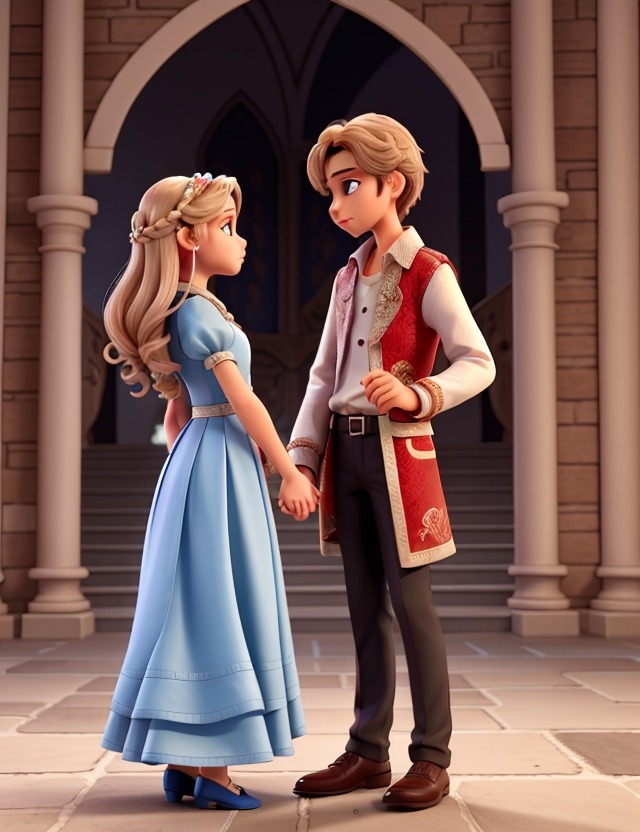Discover the timeless tale that has captured the hearts of readers for centuries, as we unravel the captivating love story of Juliet & Romeo. Penned by the legendary playwright William Shakespeare, this renowned tragedy takes us back to 16th-century Verona, where two star-crossed lovers defy fate and societal expectations to pursue their forbidden love. Exploring themes of passion, sacrifice, and the consequences of feuding families, Romeo and Juliet continues to resonate with audiences of all ages.
Join us as we delve into the secrets and complexities of this iconic masterpiece, unlocking hidden depths, and shedding light on the enduring significance of Shakespeare’s most celebrated work. Brace yourself for an unforgettable journey through time and emotions, as we dive deep into the tragic love affair that has mesmerized generations. Curious to know how Romeo and Juliet’s fateful story unfolds? Keep reading to uncover the twists and turns that will leave you on the edge of your seat.
Romeo and Juliet: Full Book Summary
Romeo and Juliet by William Shakespeare Analyisis. Romeo Juliet Story Summary
Once upon a time in the beautiful city of Verona, there lived two young lovers, Romeo and Juliet. This is a tale of a forbidden love, a love so strong that it would bring together two families torn apart by an ancient feud.
Verona was a place filled with rich traditions and proud families, the Capulets and the Montagues. The Capulets, headed by Lord Capulet, and the Montagues, led by Lord Montague, had been enemies for generations. Their bitter rivalry permeated the streets and cast a dark shadow over the city.
One day, Romeo, a sensitive and romantic boy from the Montague family, was feeling downhearted. He confided in his loyal friend, Benvolio, who wanted nothing more than to see Romeo happy again. Benvolio suggested they attend a masked ball hosted by the Capulets, hoping it would distract Romeo from his melancholy.
Romeo agreed, feeling excited and cautious as they sneaked into the extravagant ball. It was there, amidst the grandeur of the festivities, that Romeo laid eyes on the stunning Juliet, the only daughter of Lord Capulet. Juliet was kind-hearted, intelligent, and full of life. Their eyes met, and it was as if time stood still.
Instantly smitten by each other, Romeo and Juliet found solace in their stolen glances and secret conversations. Their love blossomed in the moonlight, and they could not bear to be apart. Romeo sought guidance from the wise Friar Laurence, who agreed to marry them in secret, hoping that their union would unite the feuding families.
However, fate had a different plan. Tybalt, Juliet’s fiery-tempered cousin, discovered the Montagues at the Capulets’ ball and grew furious. Tybalt challenged Romeo to a duel, aiming to avenge what he saw as a deep dishonor. But Romeo, being a lover, not a fighter, refused to engage in violence. Mercutio, Romeo’s loyal friend, stepped in to defend him. Tragically, Mercutio was fatally wounded by Tybalt, leaving Romeo heartbroken and thirsting for revenge.
Filled with grief and rage, Romeo couldn’t control his emotions and engaged in a duel with Tybalt. Romeo ultimately killed him, creating a deeper chasm between the two families. The furious Prince Escalus found out about the brawl and decided to banish Romeo from Verona as punishment for the bloodshed.
With Romeo exiled and their families’ animosity growing stronger, Juliet found herself in a precarious situation. Her parents, unaware of her secret marriage to Romeo, arranged for her to marry the noble Paris. Feeling trapped and desperate for a way out, Juliet made a brave decision.
She visited Friar Laurence, who gave her a potion that would make her appear dead for forty-two hours. Juliet would then be placed in a tomb, and Romeo would rescue her when she awoke. Friar Laurence assured Juliet that once reunited, they could flee Verona and live their lives in peace.
Juliet, filled with hope, drank the potion and fell into a deep, death-like sleep. Tragically, news of her supposed demise did not reach Romeo, who was devastated upon hearing of her death. Consumed by immense grief, he rushed back to Verona, determined to join Juliet in eternal slumber.
Romeo arrived at the Capulet tomb and encountered Paris, who was there to mourn Juliet. Seeing Paris as an obstacle, Romeo fought him, ultimately killing him. Romeo then approached Juliet’s lifeless body, professing his love and taking a potion himself, choosing death over a life without her.
Just as Romeo took the poison, Juliet woke up from her deep sleep. Seeing Romeo lying dead beside her, she could not bear to live without him. In an act of true love, Juliet took Romeo’s dagger and stabbed herself, choosing death to be reunited with her beloved forever.
Their tragic deaths shocked the warring families and finally opened their eyes to the senselessness of their feud. Realizing the immense cost of their rivalry, Lord Capulet and Lord Montague vowed to end the bitter strife and ensure that Romeo and Juliet’s love would not be in vain.
And so, the young lovers’ deaths served as a catalyst for change. The Capulets and the Montagues came together, setting aside their grudges and promising peace to honor Romeo and Juliet’s memory. Their story became legendary, a reminder of the power of love and the devastating consequences of hatred.
In the end, Romeo and Juliet’s love conquered all, defying the boundaries imposed upon them by society and their families. Their tragic tale would forever be remembered as a cautionary reminder to cherish love and seek harmony, inspiring future generations to question the destructive forces of hatred and prejudice that can tear families and communities apart.
Juliet & Romeo: Key Themes
Romeo and Juliet, one of Shakespeare’s most renowned plays, is a tragic love story set in Verona, Italy. This timeless tale explores the themes of love, fate, and the consequences of impulsive decisions that can lead to tragic outcomes.
Theme 1: Love
Love is the driving force behind Romeo and Juliet’s actions and serves as the central theme throughout the play. Shakespeare examines the powerful and passionate nature of love, portraying it as both a positive and destructive force. The love between Romeo and Juliet is intense, youthful, and forbidden due to their feuding families. Their love is impulsive and all-consuming, causing them to defy societal norms and eventually leading to their deaths. Shakespeare also contrasts this intense young love with the portrayal of mature love between Romeo’s parents, Lord and Lady Montague, and Juliet’s parents, Lord and Lady Capulet. The juxtaposition of these various expressions of love highlights the complex nature of this emotion.
Theme 2: Fate
Fate plays a significant role in Romeo and Juliet. From the beginning, the chorus foreshadows the tragic outcome, portraying the main characters as “star-crossed lovers.” Throughout the play, Shakespeare creates a sense of inevitability, suggesting that regardless of their actions, the lovers’ fate is predetermined. Romeo and Juliet often speak of their belief in fate, with Juliet famously remarking, “O fortune, fortune! All men call thee fickle” (3.5.60). The theme of fate raises questions about personal responsibility and the influence of external forces on human lives.
Theme 3: Consequences of Impulsive Decisions
Impulsive decisions made by the characters drive the plot and lead to the tragic ending. Romeo, driven by his passionate nature, makes impulsive choices throughout the play. From falling in love with Juliet at first sight to confronting Tybalt, Romeo’s impetuous actions heighten the tension and ultimately contribute to the lovers’ doom. Juliet’s decision to take a sleeping potion to avoid marrying Paris, without informing Romeo of her plan, also illustrates the disastrous effects of impulsive choices. The play serves as a cautionary tale, warning against the hasty decisions made in the heat of passion.
Romeo and Juliet explores the themes of love, fate, and the consequences of impulsive decisions. This Shakespearean tragedy delves deep into the complexities of human emotions and their consequences, reminding readers of the power of love, the fickleness of fate, and the importance of thoughtfulness in decision-making.
Romeo and Juliet: Characters
1. Romeo:
Romeo, the star-crossed lover from Verona, is a hopeless romantic with a flair for poetic expression. With his dreamy blue eyes and tousled locks of chestnut hair, he has a magnetic charm that captivates everyone around him. Though he hails from the Montague family, he falls madly in love with Juliet, a Capulet, leading to a series of tragic events. Romeo is known for his impulsive nature, often acting before thinking, and his tendency to wear his heart on his sleeve. Rumor has it that he once wrote a love sonnet every day for a month!
2. Juliet:
Juliet, a young and beautiful Capulet, possesses an enchanting aura that rivals the stars in the night sky. With her cascading ebony curls and piercing green eyes, she exudes grace and elegance. This free-spirited and intelligent young woman proves that there is more to her than her sweet appearance. Despite her tender age, Juliet displays formidable strength and determination, defying her family’s expectations and embracing forbidden love with Romeo. She enjoys stargazing and has a secret talent for reciting Shakespearean verses while standing on one foot!
3. Mercutio:
Mercutio, Romeo’s quick-witted and charismatic best friend, is the life of every party in Verona. With his wild, curly red hair and a mischievous glint in his hazel eyes, he is known for his infectious laughter and razor-sharp tongue. Mercutio thrives on wit and banter, constantly peppering his conversations with clever puns and wordplay. He is fiercely loyal to Romeo, and his boundless energy often gets him into trouble. Legend has it that he once challenged a squirrel to a dance-off at the town square!
4. Tybalt:
Tybalt, Juliet’s hot-headed cousin, is a force to be reckoned with in Verona. With his strong, chiseled jawline and piercing gray eyes, he strikes fear into the hearts of his enemies. Tybalt is known for his fiery temperament and his exceptional prowess in dueling. He always carries a sword engraved with his family crest and rarely shies away from confrontations. Rumor has it that his wardrobe consists entirely of leather jackets in various shades of black!
5. Friar Lawrence:
The wise and compassionate Friar Lawrence serves as a mentor and confidant to Romeo and Juliet. With his graying hair, kind eyes, and soothing voice, he possesses an aura of serenity and wisdom. Friar Lawrence is known for his deep knowledge of herbal remedies and alternative medicines. In his free time, he enjoys gardening and experimenting with potions. It is said that he once brewed a potion that temporarily turned him into a singing canary!
6. Nurse:
Juliet’s trusted Nurse, a plump and jovial woman, is a source of comic relief in the story. With a round face adorned with dimples and a boisterous laugh that echoes throughout the Capulet household, she is a beloved figure. The Nurse is fiercely protective of Juliet and adores her like a daughter. When she’s not attending to Juliet’s needs, she spends her days perfecting her synchronized swimming routine with the neighborhood ducks!
This list showcases the diverse and colorful cast of characters from Shakespeare’s timeless tragedy, “Romeo and Juliet”. Each character brings their unique qualities and quirks, contributing to the beauty and tragedy of the story.
Romeo and Juliet: Symbols
1. The Balcony
The balcony scene is one of the most iconic and significant moments in Romeo and Juliet. Juliet appears on her balcony, and Romeo, who is hiding in the Capulet’s garden, sees her for the first time. The balcony symbolizes a separation between them, as it represents the divide between their feuding families. However, it also becomes a symbol of their secret love and the possibility of their unification. It embodies their longing for each other and their willingness to overcome societal barriers in order to be together.
2. The Poisonous Potion
In the final act of the play, Juliet drinks a vial of potion given to her by Friar Laurence. This potion symbolizes the destructive nature of their love and the fatal consequences that arise from their impulsive decisions. The potion serves as a metaphor for their hasty actions and the poison it contains represents the tragic outcome of their forbidden love. It highlights the notion that their passion, though powerful, ultimately leads to their untimely deaths.
3. The Dagger
The dagger is an important symbol in Romeo and Juliet, as it represents both violence and a tool for self-destruction. Romeo uses a dagger to kill himself in the tragic, final scene of the play. This act symbolizes the ultimate sacrifice made for love and serves as a striking portrayal of the extent to which Romeo is willing to go for Juliet. The dagger also symbolizes the cycle of violence and the destructive power that the feud between the Capulets and the Montagues brings upon the young lovers.
Romeo and Juliet: Culture Impact
“Romeo and Juliet,” the iconic tragedy penned by William Shakespeare in the late 16th century, has left an indelible mark on global culture, cementing its reputation as one of the most influential literary works of all time. This beloved tale of star-crossed lovers has not only captivated audiences through the centuries, but has also permeated multiple facets of human existence, inspiring countless adaptations, impacting social norms, and shaping artistic expression.
Historically, “Romeo and Juliet” has served as a cultural touchstone, reflecting the social dynamics and values of Shakespeare’s time. Set in Verona, Italy, the play offers a glimpse into the political and religious tensions prevalent during the Renaissance era. Through its portrayal of the passionate and forbidden love between Romeo Montague and Juliet Capulet, the play delves into the consequences of familial rivalries and societal pressures, shedding light on the impact of these on individual lives. By exploring themes of love, fate, and the power of youthful rebellion, the play provides a window into the complexities of human emotions that remain relevant to this day.
Despite its tragic storyline, “Romeo and Juliet” has also been a source of humor throughout history. Its various adaptations and parodies have added a comedic twist to the tragic narrative, showcasing the enduring appeal and flexibility of Shakespeare’s work. From comedic reinterpretations on stage and in film, such as the 1996 film adaptation starring Leonardo DiCaprio and Claire Danes, to comedic parodies in popular culture, like the classic “Forbidden Broadway” musical, the play has inspired laughter even in the face of tragedy.
Moreover, the book’s achievements extend beyond the realm of theater and comedy. “Romeo and Juliet” gave birth to a myriad of iconic phrases and expressions that have become embedded in the English language. Lines such as “What’s in a name? That which we call a rose by any other name would smell as sweet” and “Parting is such sweet sorrow” have become deeply ingrained in popular culture, frequently quoted and referenced in literature, music, film, and everyday conversation. These enduring quotes demonstrate the profound impact of Shakespeare’s words on the collective consciousness of society.
The cultural impact of “Romeo and Juliet” is most prominently seen in the countless adaptations and reimaginations it has spawned across various media forms. From ballets and operas to modern film adaptations, theatrical renditions, and even contemporary novels and music albums, the enduring allure of the tale has inspired countless artists, allowing Shakespeare’s story to transcend time and geographic boundaries. The themes of love, sacrifice, and tragic fate explored in the play have served as a springboard for creative exploration and reinterpretation, fostering a continuous dialogue between the original work and its adaptations.
In conclusion, “Romeo and Juliet” has undeniably left an indelible cultural impact throughout history. Its historical context, ability to evoke both laughter and tears, memorable phrases, and unrivaled adaptability have made it a cornerstone of global culture. This timeless tragedy continues to resonate, reminding us of the enduring power of love, the consequences of societal pressures, and the profound and lasting impact of Shakespeare’s genius.
FAQs
1. Is Romeo and Juliet based on a true story?
No, Romeo and Juliet is not based on a true story. While the play draws inspiration from various sources, including real-life feuds in Verona, Italy, its plot and characters are entirely fictional creations by William Shakespeare.
2. Why is Romeo and Juliet considered a classic?
Romeo and Juliet is considered a classic due to its timeless themes of love, fate, and tragedy. Shakespeare’s masterful writing, vivid characters, and exploration of human emotions continue to resonate with audiences, making it one of the most celebrated works in English literature.
3. What is the setting of Romeo and Juliet?
The setting of Romeo and Juliet is Verona, a city in northern Italy during the 14th century. Verona serves as the backdrop for the feuding families, the Capulets and Montagues, and also emphasizes the conflict between tradition and individual desires.
4. What is the role of fate in Romeo and Juliet?
Fate is a major theme in Romeo and Juliet, as it seems to control the characters’ actions and destinies. The play begins with a prologue that states that Romeo and Juliet are “star-crossed lovers” who are doomed to die because of their families’ conflict. Throughout the play, there are many references to fate, such as the words “fortune”, “chance”, “destiny”, and “stars”. The characters often blame fate for their misfortunes, and try to defy or escape it. However, fate always seems to intervene and thwart their plans, leading to their tragic end.
5. Do Romeo and Juliet really love each other?
Yes, Romeo and Juliet’s love for each other is one of the central themes of the play. They are portrayed as star-crossed lovers who defy familial expectations and societal norms to be together. Their intense and passionate love for one another ultimately leads to their untimely deaths.
6. Why do Romeo and Juliet kill themselves?
Romeo and Juliet kill themselves because they believe that they cannot live without each other. They are victims of a tragic misunderstanding, as they are unaware of each other’s plans to fake their deaths and escape their families’ feud. Romeo thinks that Juliet is really dead, and drinks a poison to join her in death. Juliet then wakes up from her fake death, and sees Romeo’s corpse. She then stabs herself with his dagger, and dies beside him.
7. How does Romeo and Juliet relate to the social and historical context of Elizabethan England?
Romeo and Juliet reflects the social and historical context of Elizabethan England, which was a time of political and religious turmoil, as well as cultural and artistic flourishing. Shakespeare wrote the play during the reign of Queen Elizabeth I, who faced many threats and challenges to her authority, such as the Spanish Armada, the Catholic plots, and the succession crisis. The play also reflects the religious conflicts between the Protestants and the Catholics, as well as the influence of the Renaissance and humanism on literature and philosophy. The play also explores the issues of gender, class, family, and violence that were relevant to the Elizabethan society .
8. How does Romeo and Juliet influence the modern culture and media?
Romeo and Juliet has a significant influence on the modern culture and media, as it is widely regarded as one of the most influential and beloved works of literature. The play has inspired many adaptations and variations in various media, such as films, plays, musicals, operas, ballets, cartoons, and parodies. The play also popularized many of the elements and tropes that are associated with the genre of romance, such as the love at first sight, the balcony scene, the forbidden love, the love triangle, the tragic ending, and the star-crossed lovers. The play also introduced many famous phrases and expressions that are still used today, such as “Romeo, Romeo, wherefore art thou Romeo?”, “A plague on both your houses!”, “Parting is such sweet sorrow”, and “What’s in a name?” .
9. What are some of the literary devices and techniques that Shakespeare uses in Romeo and Juliet?
Shakespeare uses many literary devices and techniques in Romeo and Juliet, such as the following:
- Metaphor: A figure of speech that compares two things that are not alike, such as when Romeo compares Juliet to the sun, or when Juliet compares Romeo to a rose.
- Simile: A figure of speech that compares two things using the words “like” or “as”, such as when Romeo says that Juliet is “like a rich jewel in an Ethiope’s ear”, or when Juliet says that parting with Romeo is “like lightning”.
- Personification: A figure of speech that gives human qualities to non-human things, such as when Romeo says that the night is “envious” and “black”, or when Juliet says that the moon is “sick and pale”.
- Oxymoron: A figure of speech that combines two contradictory words, such as when Romeo says that he is “a feather of lead”, or when Juliet says that Romeo is “a beautiful tyrant”.
- Allusion: A reference to another work of literature, history, mythology, or culture, such as when Romeo compares Juliet to Helen of Troy, or when Mercutio mentions Queen Mab, the fairy queen.
- Foreshadowing: A hint or clue that suggests what will happen later in the story, such as when Romeo says that he has a “soul of lead”, or when Juliet says that she has an “ill-divining soul”.
- Irony: A contrast between what is expected and what actually happens, such as when Romeo and Juliet fall in love without knowing each other’s identity, or when Friar Laurence’s plan to reunite them fails because of a delay in communication .










